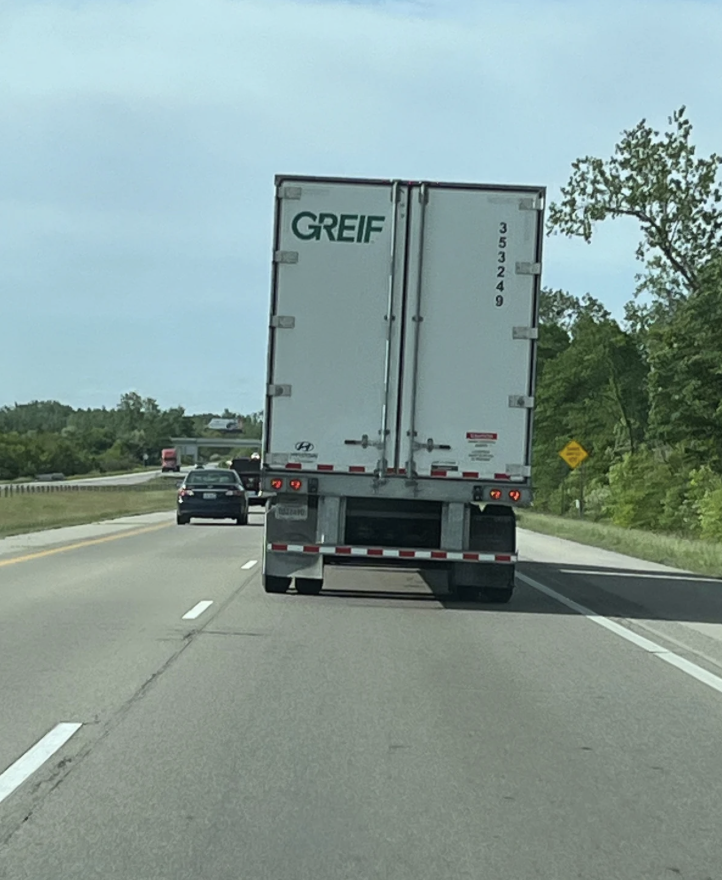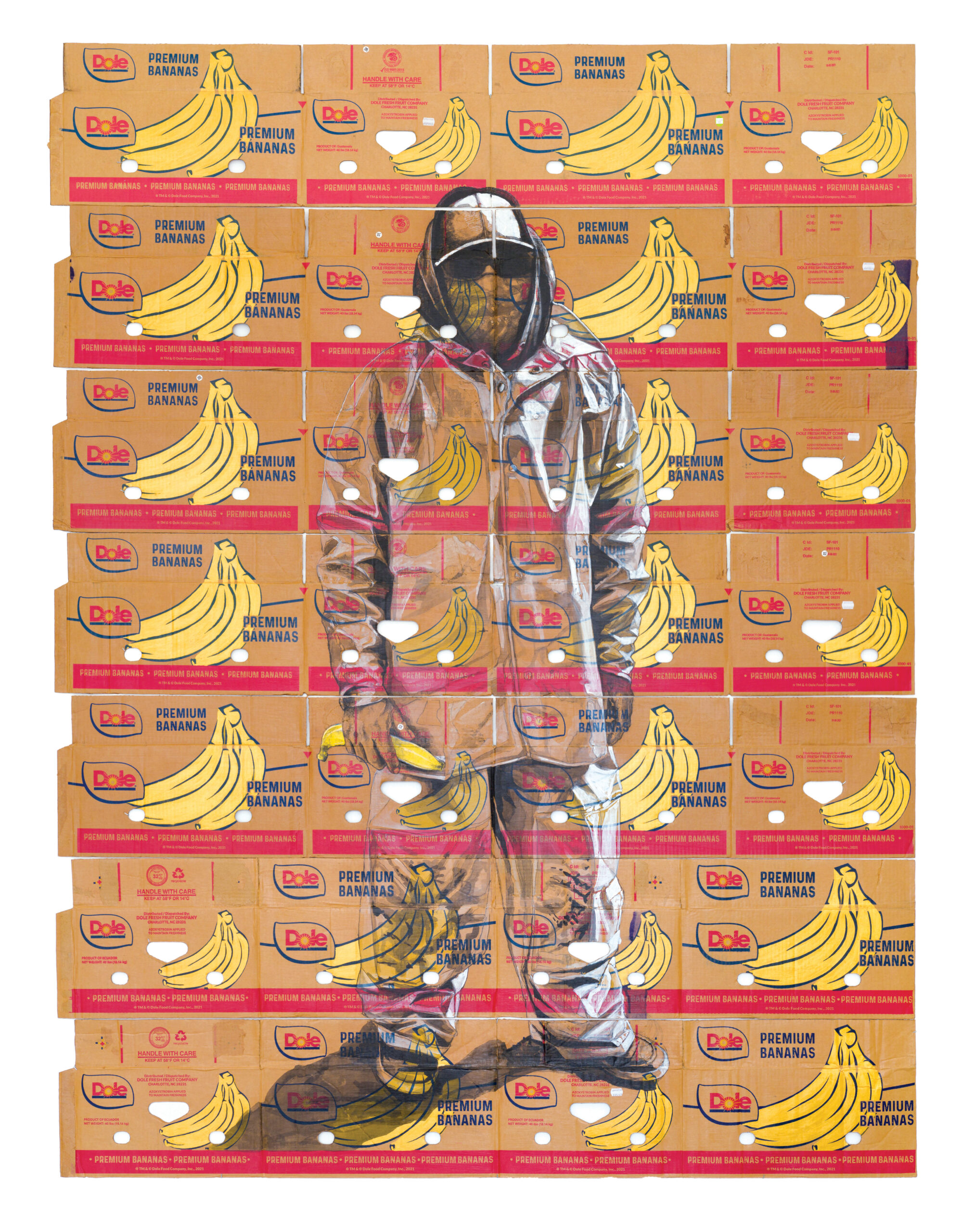By BRIAN SHOLIS
In a photograph Robert Adams took northeast of Riverside, California, in 1982, serpentine paths lead toward the horizon line; it’s not easy to discern whether these are creeks, dirt trails, or roads. Human presence takes the form of wooden poles carrying electric wires, which stride diagonally from the bottom left of the composition toward the distance at right. Scrubby brush covers the low hill that spreads out beneath Adams’s camera, a few trees poke up disconsolately here and there, and a larger hill dominates the right-hand edge of the picture. In the distance is the radiance of an invisible sun, an onrushing whiteness that presses toward the camera and blots out the landscape’s details.
The photograph, part of a series titled Los Angeles Spring, was included in the magnificent retrospective devoted to Adams’s career, now stretching to five decades, that I saw at the Yale University Art Gallery in late 2012. The exhibition was a revelation even for viewers familiar with Adams’s photographs. He is perhaps best known for the work he made from the late 1960s to the late ’70s on the fringes of cities such as Denver and Colorado Springs. Subdivisions, often still under construction, sprout from the earth at the places where these cities edge into the foothills of the Rockies. This “New West,” as he termed it, of tract houses and gasoline stations, of burning oil sludge and trash-strewn parking lots, is starkly rendered in small black-and-white prints.
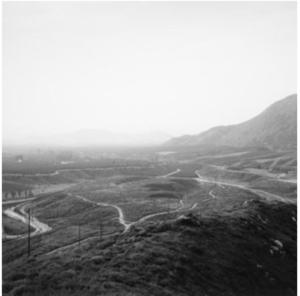
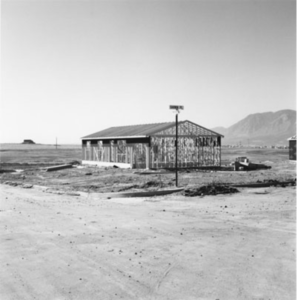 Adams was included in the seminal 1975 exhibition New Topographics: Photographs of a Man-Altered Landscape, curated by William Jenkins for the International Museum of Photography at George Eastman House in Rochester, New York. His work was presented alongside that of a cohort of mostly American photographers, including Frank Gohlke, Joe Deal, Lewis Baltz, and Stephen Shore. What unified these works, in Jenkins’s words, was that “the photographers’ influence on the look of the subject is minimal,” and the term “New Topographics” has since become shorthand for an affectless documentary style in landscape photography. In the popular imagination, this is understood as heralding a sober, almost somber criticism of humankind’s incursion into beautiful, pristine landscapes.
Adams was included in the seminal 1975 exhibition New Topographics: Photographs of a Man-Altered Landscape, curated by William Jenkins for the International Museum of Photography at George Eastman House in Rochester, New York. His work was presented alongside that of a cohort of mostly American photographers, including Frank Gohlke, Joe Deal, Lewis Baltz, and Stephen Shore. What unified these works, in Jenkins’s words, was that “the photographers’ influence on the look of the subject is minimal,” and the term “New Topographics” has since become shorthand for an affectless documentary style in landscape photography. In the popular imagination, this is understood as heralding a sober, almost somber criticism of humankind’s incursion into beautiful, pristine landscapes.
Such critique is one aspect of Adams’s vision, but what struck me while viewing the exhibition at Yale was the humor and irony of these early pictures. There is the wood-stud framing of a house under construction behind a street-corner sign, which one can read: DARWIN PL. Evolution and survival of the fittest; you can almost hear Adams slamming the brakes as he passes by, then see him figuring out how best to frame the shot. Or there is the poster, hanging from a liquor store’s ceiling, that creeps into the top of a photograph made in Longmont, Colorado. It announces: we’re glad you’re here!
What also became visible, as I walked through gallery after gallery of Adams’s photographs, was that this humor and irony, over the decades, flattens out into something starker. The emotional range of the photographs broadens, and tends to hover at the either end of the pendulum’s swing. The critique of our destruction of the landscape becomes more pointed; conversely, the celebration of the persistence of beauty in these places becomes increasingly devout. One recent series, inspired by the bicentennial of the Lewis and Clark expedition of 1804–06, depicts large fields of stumps left behind by industrial clear-cutting in Oregon, where Adams now lives. Another body of work contains scores of photographs of light dancing through canopies of foliage. You’d call them sentimental were the sentiments not shored up by decades of unromantic witnessing.
In this sense Adams has come to convey with greater visual force the opinions about the landscape he has expressed in words all along. The wall texts in the Yale exhibition, drawn from Adams’s own writing and interviews, revealed that, from the beginning, the verbal framework he has given his art has had an unadorned gravity. Here is part of what Adams said about the series encompassing the photograph taken at the edge of Riverside in 1982: “Southern California was, by the reports of those who lived there at the turn of the century, beautiful…. Even now we can almost extrapolate an Eden from what has lasted—from the architecture of old eucalyptus trunks, for example, and from the astringent perfume of the trees’ flowers as it blends with the sweetness of orange blossoms.”[1] And: “Whether those trees that stand are reassuring is a question for a lifetime. All that is clear is the perfection of what we were given, the unworthiness of our response, and the certainty, in view of our current deprivation, that we are judged.” Elsewhere, in the introduction to his 1974 book The New West, Adams writes, “all land, no matter what has happened to it, has over it a grace, an absolutely persistent beauty.”
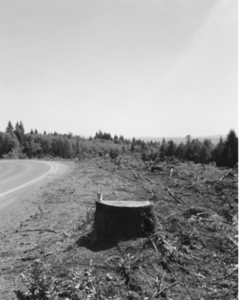
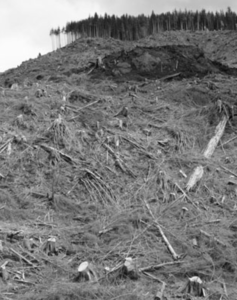
Eden, unworthiness, ultimate judgment, grace: Adams’s is a biblical language of sin and possible redemption. Thinking of the Riverside picture in these terms, one can understand the blinding whiteness of the sun as a metaphor. Not only is it representative of our own destructiveness, suggesting that the further we push down the path of sprawl and development, the less of the current landscape’s beauty we’ll be able to see; it is also a symbol of our inability to comprehend what lies beyond this process—whether you believe that is more like heaven or hell. In Adams’s view, the landscape is sacred. And the quality of attention he gives to it is itself a form of prayer. At Yale, while I looked at hundreds of Adams’s beautiful photographs, beautiful even when they are records of humankind’s most wanton destruction, the treatment of landscape in an altogether different artist’s work came inexorably to mind.
***
The landscape is an active presence, alternately malign and benevolent, in Marilynne Robinson’s first novel, Housekeeping, published two years before Adams took his photograph in Southern California. Set in a small town in what critics presume to be the author’s native Idaho, the book opens with the narrator Ruth’s account of her grandfather’s death. A railroad employee, Edmund Foster was one of a few people on a late-night train crossing a bridge “when the engine nosed over toward the lake and then the rest of the train slid after it into the water like a weasel sliding off a rock.” The lake, and the ability it has to both nourish and extinguish life, features prominently throughout the novel. “It is true that one is always aware of the lake in Fingerbone, or the deeps of the lake, the lightless, airless waters below,” Robinson writes. Later in the book, Ruth’s Aunt Sylvie wanders out to the middle of the bridge and contemplates the water forebodingly, unaware that Ruth and her sister are watching with trepidation from the lakeshore nearby.
The language in Housekeeping is studded intermittently with religious terms likerelics and grace. Robinson’s second novel, Gilead, published in 2004 but set in the 1950s, reverses the balance between religious feeling and landscape description. Piety suffuses the book, whose narrator is the Reverend John Ames, an ailing septuagenarian minister chronicling his wisdom and experiences for his young son. The plot, such as it is, retells the biblical story of the prodigal son, when John Ames Boughton, son of the narrator’s best friend, neighbor, and fellow pastor, returns to Gilead, Iowa, after being away for many years. Ames grapples with his complex feelings about his namesake, making Gilead, by comparison to Robinson’s earlier book, markedly inward-looking.
As the story progresses, Ames describes the land only occasionally. More prevalent are descriptions of light, the material of photography. There is a scene, early in the novel, in which Ames and his father wander the Kansas plains in search of the elder’s father’s grave. As Ames pauses to pray, he looks around: “I realized that what I saw was a full moon rising just as the sun was going down. Each of them was standing on its edge, with the most wonderful light between them. It seemed as if you could touch it….” He gently interrupts his father, who responds to the sight: “I would never have thought this place could be beautiful. I’m glad to know that.”
The Reverend Ames’s attention to “this poor perishable world” begins to sound like a description of some of Adams’s best photographs, which are as much about light as they are about the places the light bathes. Here is Ames: “There was the feeling of the weight of light—pressing the damp out of the grass and pressing the smell of sour old sap out of the boards on the porch floor and burdening even the trees a little as a late snow would do. It was the kind of light that rests on your shoulders the way a cat lies on your lap. So familiar.” Or, toward the end of Gilead: “I love the prairie! So often I have seen the dawn come and the light flood over the land and everything turn radiant at once, that word ‘good’ so profoundly affirmed in my soul that I am amazed I should be allowed to witness such a thing.” Adams is himself a witness, an intervening agent who grants us access to profound experiences of landscape, whether pristine or flayed.
***
Perhaps these correspondences should not be surprising. Adams (born in 1937) and Robinson (born in 1943) are of the same generation. Religion was an important aspect of their upbringings. Both have studied classic literature and poetry: Adams earned a Ph.D. in English literature as he was taking up photography in earnest, and Robinson has taught writing and literature for several decades, most recently at the Iowa Writers’ Workshop. Yet there are many other ways to depict what Robinson has called the “vast and melancholy” places of the American West, whether in pictures or in words. And it is she who has best articulated, in an essay titled “Wilderness,” the animating impulse that I believe underpins both their bodies of work. “I started writing fiction at an eastern college, partly in hopes of making my friends there understand how rich and powerful a presence a place can be which, to their eyes, is forbidding and marginal, without population or history, without culture in any form recognizable to them.” She continues: “All love is in great part affliction. My bond with my native landscape was an unnamable yearning, to be at home in it, to be chastened and acceptable, to be present in it as if I were not present at all.”
***
I am not from the American West, nor have I spent much time there. Artists and writers like Adams and Robinson are my reference points for understanding the region. Finding myself in Portland, Oregon, last July, one morning I awoke before dawn to drive to the coast—to drive into what I consider Robert Adams territory. Heading west on Route 26, a ribbon of blacktop parting the evergreen forest, I began to understand, tentatively, the awe such a landscape can inspire. As I stood in the mist and fog on Cannon Beach, with Haystack Rock looming just offshore, the severe beauty and the endlessness of the water made me wish I could be “present in it as if I were not present at all.” Later, driving back to the city, I could see, through the scrim of trees left standing roadside, large bald patches of clear-cut forest extending along the ridges. I felt the simple despair of a child or an animal who has had something arbitrarily taken away.
Both Adams and Robinson understand this feeling. In the foreword to his first book of essays, Adams quotes the writer Eudora Welty. A character in her book The Golden Apples thinks, “[A]ll the opposites on earth [are] close together,” and “of them all, hope and despair [are] the closest blood.” Adams continues: “That is, it seems to me, what each of us experiences.” On the final page of Gilead, Robinson’s narrator speaks at length about the place in which he passed his seventy-seven years. “This whole town does look like whatever hope becomes after it begins to weary a little, then weary a little more. But hope deferred is still hope. I love this town. I think sometimes of going into the ground here as a last wild gesture of love—I too will smolder away the time until the great and general incandescence.”
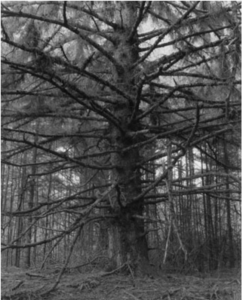 Brian Sholis is an associate curator of photography at the Cincinnati Art Museum. Formerly an editor at Artforum and the Aperture Foundation, he writes about landscapes, photography, and American history for a wide range of publications.
Brian Sholis is an associate curator of photography at the Cincinnati Art Museum. Formerly an editor at Artforum and the Aperture Foundation, he writes about landscapes, photography, and American history for a wide range of publications.
[Click here to purchase your copy of Issue 08]
[1] Robert Adams: The Place We Live, A Retrospective Selection of Photographs, 1964-2009.


